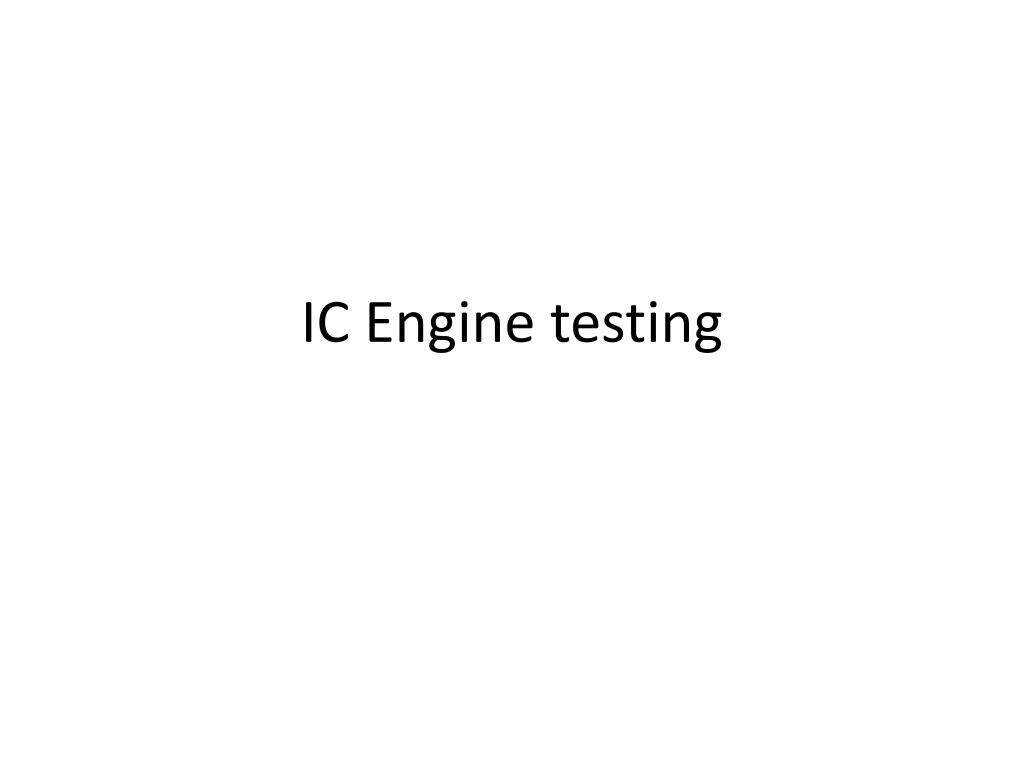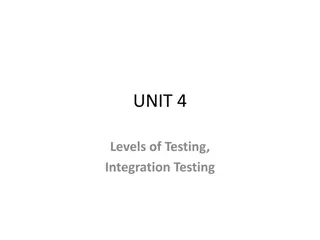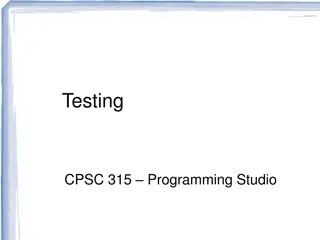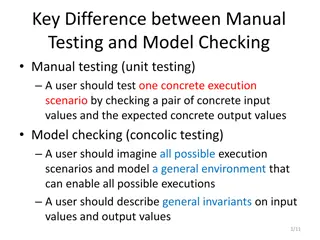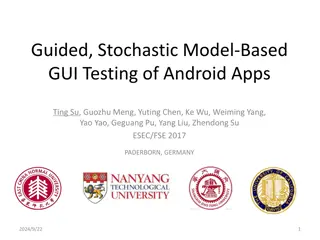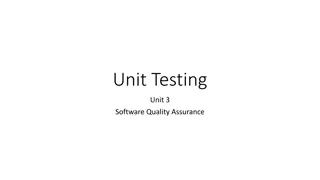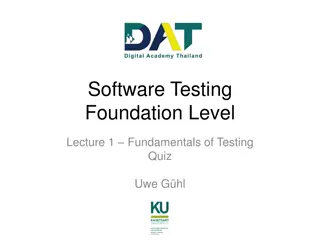Overview of IC Engine Testing and Types
Engine testing plays a crucial role in evaluating performance beyond calculations and design data, ensuring customer satisfaction. Commercial tests help determine power output, fuel consumption, and overall engine stability under various loads. Thermodynamic tests compare theoretical and actual performance, assessing efficiency and heat balance. Pollution Under Control (PUC) tests focus on adjusting air-fuel mixtures to limit emissions. Explore the various types of testing to understand engine behavior and optimize performance.
- IC Engine Testing
- Performance Evaluation
- Engine Efficiency
- Commercial Testing
- Thermodynamic Analysis
Download Presentation

Please find below an Image/Link to download the presentation.
The content on the website is provided AS IS for your information and personal use only. It may not be sold, licensed, or shared on other websites without obtaining consent from the author. Download presentation by click this link. If you encounter any issues during the download, it is possible that the publisher has removed the file from their server.
E N D
Presentation Transcript
Purpose of Engine Testing 1. To determine the information which can t be obtained by calculation. 2. To confirm the data used in design. 3. To satisfy the customer regarding the performance of the engine.
Types of Test 1. Commertial Test : Used to determine Rated power o/p w.r.t. fuel consumption. Quantity of lubricating oil and cooling water required. Steadiness of engine when loaded at different load. To check timing of valves and injection of fuel or spark made. Overload carrying capacity of engine.
Types of Test 2. Thermodynamic test : It compare the actual performance with theoretical results.It determine : I.P., B.P., F.P. Indicated mean effective pressure. Fuel consumption. Air consumption. Mechanical , thermal and volumetric efficiency. Heat balance sheet. Flow rate f cooling water. Heat carried away by exhaust gases.
Types of test 3. PUC test ( Pollution under control ) What is PUC ? It is the process of adjusting the air fuel mixture to adjust the CO and HC within limits. CO measured in % and HC in ppm ( parts per million )
Purpose of Engine Testing 1. To determine the information which can t be obtained by calculation. 2. To confirm the data used in design. 3. To satisfy the customer regarding the performance of the engine.
Types of Test 1. Commertial Test : Used to determine Rated power o/p w.r.t. fuel consumption. Quantity of lubricating oil and cooling water required. Steadiness of engine when loaded at different load. To check timing of valves and injection of fuel or spark made. Overload carrying capacity of engine.
Types of Test 2. Thermodynamic test : It compare the actual performance with theoretical results.It determine : I.P., B.P., F.P. Indicated mean effective pressure. Fuel consumption. Air consumption. Mechanical , thermal and volumetric efficiency. Heat balance sheet. Flow rate f cooling water. Heat carried away by exhaust gases.
Types of test 3. PUC test ( Pollution under control ) What is PUC ? It is the process of adjusting the air fuel mixture to adjust the CO and HC within limits. CO measured in % and HC in ppm ( parts per million )
Friction Power F.P. = I.P. - B.P. Friction Power = Indicated Power Brake Power
Measurement of F.P. Motoring Test William Straight line method Morse test
Motoring Test Engine is first run up to the desired speed by its own power. Engine is allow to run under same speed and load condition for some time ,so that temperature of oil ,Water and engine components reach stable conditions. The power of the engine during the period is absorbed by the dynamometer.
Motoring Test The fuel supply is then cut off and suitable electric switching devices convert the dynamometer to run as a motor to drive the engine at the same speed. The power supplied to the motor is measured and is the measure of friction power of the engine.
William straight line method A graph of Fuel consumption( mf) Vs Brake power is plotted at constant speed. A point where Straight line cuts the B.P.axis is the F.P. of the engine.
Morse Test Consider a four cylinder engine. When all the cylinders are in operation the B.P. of the engine is measured at constant speed and load. Cut off the petrol engine cylinder is done by short circuiting a spark plug Cut off of diesel engine cylinder is done by cutting of fuel supply of the cylinder.
Morse Test If one of the cylinder is cut off then speed of the engine decreases in order to bring speed of the engine to the original speed load on the engine is reduced. The B.P.is measured in this condition and it gives the B.P. of the remaining three cylinders. Let I1,I2,I3,I4 = I.P. of each individual cylinder F1,F2,F3,F4 = F.P. of each individual cylinder
Morse Test Total B.P. of the Engine= Total I.P. Total F.P. B = ( I1+I2+I3+I4) ( F1+F2+F3+ F4 ) ( A) When cylinder 1 is cut off ,Then I1 = 0 but the Friction losses of the cylinder remains same. B.P. of the remaining 3 cylinders is B1 = ( 0+I2+I3+I4) ( F1+F2+F3+ F4 ) ---(B) Subtracting equation B from A we get, B B1 = I1
Morse Test Similarly I.P.of Second cylinder I2 = B - B2 I.P. of third cylinder I3 = B - B3 I.P. of fourth cylinder I4 = B - B4 Total I.P. = I1 +I2 +I3 +I4 F.P. = I.P. B.P.
Heat balance sheet 1. It is the account of heat supplied and heat utilized in various ways in the system. 2. It gives the information of the performance of the engine. 3. It is done of second/ minute/ hour basis 4. To draw heat balance sheet complete test on the engine is carried out at constant speed.
Calculation of heat Balance Sheet I ) Heat supplied by fuel : 1) For petrol / oil engine : Heat supplied = mf x C.V. KJ/Min Where , mf = Mass flow rate of fuel in Kg.min Cv = Calorific value of fuel in KJ/Kg 2) For gas engine : Heat supplied = V X C.V. Where, V = volume of gas supplied per minute.
Calculation of heat Balance Sheet II ) Heat expenditure / Heat utilized : Heat energy of the fuel is partly converted into useful work equivalent to B.P. Remaining heat is carried away by a) cooling water b) Exhaust gases c) Radiation, incomplete combustion , lubricating oil. A) Heat equivalent to B.P. = B.P. x 60 in KJ /min B) Heat rejected to cooling water : Qw = Mw x Cpw x ( t2-t1) Where Cpw= 4.187 KJ/KgK
Calculation of heat Balance Sheet C) Heat carried away by exhaust gas : Qeg = Meg x Cpeg x ( tf tr) Where , Meg = Mf + Mg tf= temperature of flue gas tr = temperature of engine. Cpeg = Specific heat of exhaust gas.
Heat Balance Sheet Heat Supplied KJ/min % Heat Expenditure KJ/min % Heat supplied by combustion of fuel Qs 100 Heat equivalent to Brake Power Qb Qb/Qs x 100 Heat lost to cooling water Qw Qw/Qs x 100 Heat lost by exhaust gas Qeg Qeg/Qs x 100 Heat lost by radiation Qu Qu/Qs x 100 Total Qs 100 Equal to Qs 100
Construction & Working 1) It consists of a cylindrical unit of small size and installed into the exhaust system of the vehicle. 2) It is placed between exhaust manifold and silencer. 3) Inside the cylindrical tube there is honey comb like structure of ceramic or metal. 4) The structure is coated alumina based material as a primary coating and secondary coating of precious materia metals such as platinum or rhodium or combination. 5) The second coating serves as catalyst. 6) The catalyst is the substance which causes rapid chemical reaction.
Construction and Working 7) When the exhaust gases pass through the catalytic converter there is chemical reaction Between Rhodium which act as a reduction catalyst converting NOx into nitrogen and Oxygen. 8) If second coating is of platinum or Palladium they act as a oxidation catalyst which convert HC into H2O and CO2 or CO into CO2.
Construction and Working 1) It has a mesh or honeycomb metal construction. 2) The catalyst coated on mesh or honeycomb. 3) It is installed in exhaust line between manifold and silencer. 4) In first stage : Rhodium is plated over the honeycomb structure as a catalyst, It perform reduction process in which NOx is reduces to N2 and O2 5) In second stage : Platinum is coated over the honeycomb structure as a catalyst, also air pump is provided after first stage so that oxidation process will takes place which converts HC into H2O and CO2 and CO into CO2.
Construction and Working 1) It has a mesh or honeycomb metal construction. 2) The catalyst coated on mesh or honeycomb. 3) It is installed in exhaust line between manifold and silencer. 4) In first stage : Rhodium is plated over the honeycomb structure as a catalyst, It perform reduction process in which NOx is reduces to N2 and O2 5) In second stage : Platinum is coated over the honeycomb structure as a catalyst, also air pump is provided after first stage so that oxidation process will takes place which converts HC into H2O and CO2 and CO into CO2.
What is Bharat Stage Bharat stage emission standards are emission standards instituted by the Government of India to pollutants from internal combustion engine equipment, including motor vehicles. The standards and the timeline for implementation are set by the Central Pollution Control Board under the Ministry of Environment & Forests and climate change.[1] The standards, based on European regulations were first introduced in 2000. Progressively stringent norms have been rolled out since then. All new vehicles manufactured after the implementation of the norms have to be compliant with the regulations.[2]Since October 2010, Bharat Stage (BS) III norms have been enforced across the country. In 13 major cities, Bharat Stage IV emission norms have been in place since April 2010.[3]In 2016, the Indian government announced that the country would skip the Euro V norms altogether and adopt Euro VI norms by 2020.[4] regulate the output of air
The phasing out of 2-stroke engine for two wheelers, the stoppage of production of Maruti 800 & introduction of electronic controls have been due to the regulations related to vehicular emissions.[5] While the norms help in bringing down pollution levels, it invariably results in increased vehicle cost due to the improved technology & higher fuel prices. However, this increase in private cost is offset by savings in health costs for the public, as there is lesser amount of disease causing particulate matter and pollution in the air. Exposure to air pollution can lead to respiratory and cardiovascular diseases, which is estimated to be the cause for 6.2 lakh early deaths in 2010.
